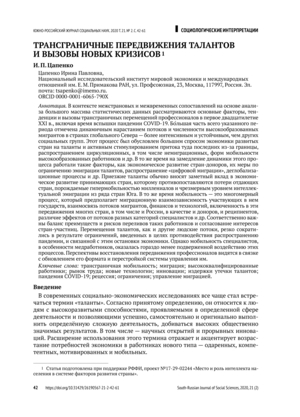Аннотация
В контексте межстрановых и межвременных сопоставлений на основе анализа большого массива статистических данных рассматриваются основные факторы, тенденции и вызовы трансграничных перемещений профессионалов в первое двадцатилетие XXI в., включая время вспышки пандемии CОVID‑19. Большая часть всего указанного периода отмечена динамичным нарастанием потоков и численности высокообразованных мигрантов в странах глобального Севера — более интенсивным и устойчивым, чем других социальных групп. Этот процесс был обусловлен большим спросом экономики развитых стран на таланты и активным стимулированием притока туда последних из-за границы, распространением циркуляционных, в том числе немиграционных, форм мобильности высокообразованных работников и др. В то же время на замедление динамики этого процесса работали такие факторы, как экономическое развитие стран-доноров, их меры по ограничению эмиграции талантов, распространение «цифровой миграции», деглобализационные процессы и др. Приезжие таланты обычно вносят заметный вклад в экономическое развитие принимающих стран, которому противопоставляются потери отдающих стран, порождаемые гипермобильностью миллениалов и чрезмерным уровнем интеллектуальной эмиграции из ряда стран Юга. В то же время мобильность — это многомерный процесс, который предполагает миграционную взаимозависимость участвующих в нем государств, взаимосвязь потоков мигрантов, финансов и технологий, включенность в эти передвижения многих стран, в том числе и России, в качестве и доноров, и реципиентов, различие эффектов от потоков разных категорий специалистов и др. Соответственно важны баланс преимуществ и рисков переливов таких работников и согласование интересов стран-участниц. Перемещения талантов, как и другие людские потоки, резко сократились в результате ограничений, введенных в целях противодействия распространению пандемии, и связанной с этим остановки экономики. Однако мобильность специалистов, в особенности медработников, оказалась гораздо менее подверженной воздействию этих процессов. Перспективы восстановления передвижения профессионалов видятся в связке с обновлением его формата и перестройкой системы управления им.
Ключевые слова
Информация о финансировании
Статья подготовлена при поддержке РФФИ, проект №17-29-02244 «Место и роль интеллекта населения в системе факторов развития страны».
Библиографические ссылки
Aiglepierre, R. et al. (2020). A Global Profile of Emigrants to OECD Countries. OECD Social, Employment and Migration Working Paper.
Alesina, A., Harnoss, J., Rapoport, H. (2013). Birthplace Diversity and Economic Prosperity. In IZA DP, Retrieved from https://scholar.harvard.edu/files/alesina/files/birthplacediversityprosperityjoegrevisedaug16.pdf.
Arslan, C. et al. (2014). A New Profile of Migrants in the Aftermath of the Recent Economic Crisis. OECD Social, Employment and Migration Working Paper, 160. Retrieved from http://dx.doi.org/10.1787/5jxt2t3nnjr5-en
Bailey, A., Mulder, C. (2017). Highly Skilled Migration between the Global North and South: Gender, Life Courses and Institutions. Journal of ethnic and migration studies, 43(16), 2689–2703.
BCG (2018). Decoding Global Talent 2018. Retrieved from https://image-src.bcg.com/Images/BCG-Decoding-Global-Talent-2018-Jun-2018_tcm9-207928.pdf
Bhagwati, J., Rodriguez, C. (1975). Welfare-Theoretical Analyses of the Brain Drain. Journal of Development Economics, 2(3), 195–221.
Brzozowski, J. (2008). Brain Drain or Brain Gain? The New Economics of Brain Drain Reconsidered. (October 22, 2008). Retrieved from http://dx.doi.org/10.2139/ssrn.1288043
Buchan, J. et al. (2019). Labour Market Change and the International Mobility of Health Workers. Health Foundation working paper, 5. Retrieved from https://www.health.org.uk/sites/default/files/upload/publications/2019/Labour%20market%20change%20and%20the%20international%20mobility%20of%20health%20workers%20Working%20Paper_0.pdf
Docquier, F., Marfouk, A. (2006). International Migration by Education Attainment, 1990–2000. In International Migration, Remittances and the Brain Drain (pp. 151–199). Washington: World Bank.
Docquier, F., Rapoport, H. (2012). Globalization, Brain Drain, and Development. Journal of Economic Literature, 50(3), 681–730.
Eurostat (2017). Migrant Integration Statistics. Luxemburg: Eurostat.
Florida, R. (2005). The Flight of the Creative Class: the New Global Competition for Talent. New York: HarperCollins.
Gamlen, A. (2020). Migration and Mobility after the 2020 Pandemic: The End of an Age? University of Oxford, Centre on Migration, Policy and Society. Retrieved from https://www.compas.ox.ac.uk/2020/migration-and-mobility-after-the-2020-pandemic-the-end-of-an-age-2/
Gontmakher, E., Grishin, I., Tsapenko, I. (Eds) (2016). Social'nyy kontekst ekonomicheskogo razvitiya v XXI veke [Social Context of Economic Development in the XXI Century]. M: IMEMO RAN.
Hanson, G. (2008). The Economic Consequences of the International Migration of Labor. Annual Review of Economics, 1, 173–209. Retrieved from http://irpshome.ucsd.edu/faculty/gohanson/AREImmigrationHanson1008.pdf
Kerr, W. (2018). The Gift of Global Talent. Stanford: Stanford Business Books.
King, R. (2012). Theories and Typologies of Migration: An Overview and a Primer. Willy Brandt Series of Working Papers in International Migration and Ethnic Relations. Malmö: Malmö University.
Nathan, M. (2011). The Economics of Super-Diversity: Findings from British Cities, 2001–2006. SERC Discussion Paper 68. Retrieved from http://www.spatialeconomics.ac.uk/textonly/SERC/publications/download/sercdp0068.pdf
OECD (2018). Settling in 2018: Indicators of Immigrant Integration. Paris: OECD Publishing.
OECD (2019a). Education at a Glance 2019. Paris: OECD Publishing.
OECD (2019b). How do OECD Countries Compare in Their Attractiveness for Talented Migrants? Migration Policy Debates. Retrieved from https://www.oecd.org/els/mig/migration-policy-debates-19.pdf
Ozgen, C., Nijkamp, P., & Poot J. (2013). Measuring Cultural Diversity and its Impact on Innovation. Retrieved from: http://ftp.iza.org/dp7129.pdf
PwC (2018). The Talent Challenge: Rebalancing Skills for the Digital Age. PwC’s 21st CEO Survey: Talent. 2018. Retrieved from www.ceosurvey.pwcww.ceosurvey.pwc
Sadovaya, E. S., Sautkina, V. A., Zenkov, A. R. (2019). Formirovanie novoy social'noy real'nosti: tekhnologicheskie vyzovy [Formation of a New Social Reality: Technological Challenges]. M: IMEMO RAN.
Saxenian, A. L. (2005). From Brain Drain to Brain Circulation: Transnational Communities and Regional Upgrading in India and China. Studies in Comparative International Development, 40(2), 35–61.
Solimano, A. (2008). The International Mobility of Talent. New York: Oxford University Press.
Stark, O., Simon Fan, C. (2007). Losses and Gains to Developing Countries from the Migration of Educated Workers: An Overview of Recent Research, and New Reflections. ZEF Discussion Papers on Development Policy.
The Global Talent Competitiveness Index 2015–2016 (2016). INSEAD.
Tsapenko I. (2018). Cross-Border Mobility: Updating the Format. Herald of the Russian Academy of Sciences, 88(5), 369–378.
Tsapenko, I., Sautkina, V. (2017). Transgranichnaya mobil'nost' v sfere zdravoohraneniya [Cross-border Mobility in Healthcare]. Chelovek. Soobshchestvo. Upravlenie [Human. Community. Management] 18(2), 6–24.
Tuccio, M. (2019). Measuring and Assessing Talent Attractiveness in OECD Countries. OECD Social, Employment and Migration Working Paper. Retrieved from https://www.oecd.org/migration/mig/Measuring-and-Assessing-Talent-Attractiveness-in-OECD-Countries.pdf
UN (2020). World Population Policies 2019. N.Y.: UN. Retrieved from https://www.un.org/en/development/desa/population/publications/pdf/policy/World_Population_Policies_2019.pdf
Weinar, A., Klekowski von Koppenfels, A. (2020). Highly-skilled Migration: between Settlement and Mobility. Springer, IMISCOE Research Series.
Yurevich, M. A., Malakhov, V. A., Aushkap, D. S. (2019). Global Experience in Interaction with Compatriot Scientists: Lessons for Russia. Herald of the Russian Academy of Sciences, 89(4), 342–350.


